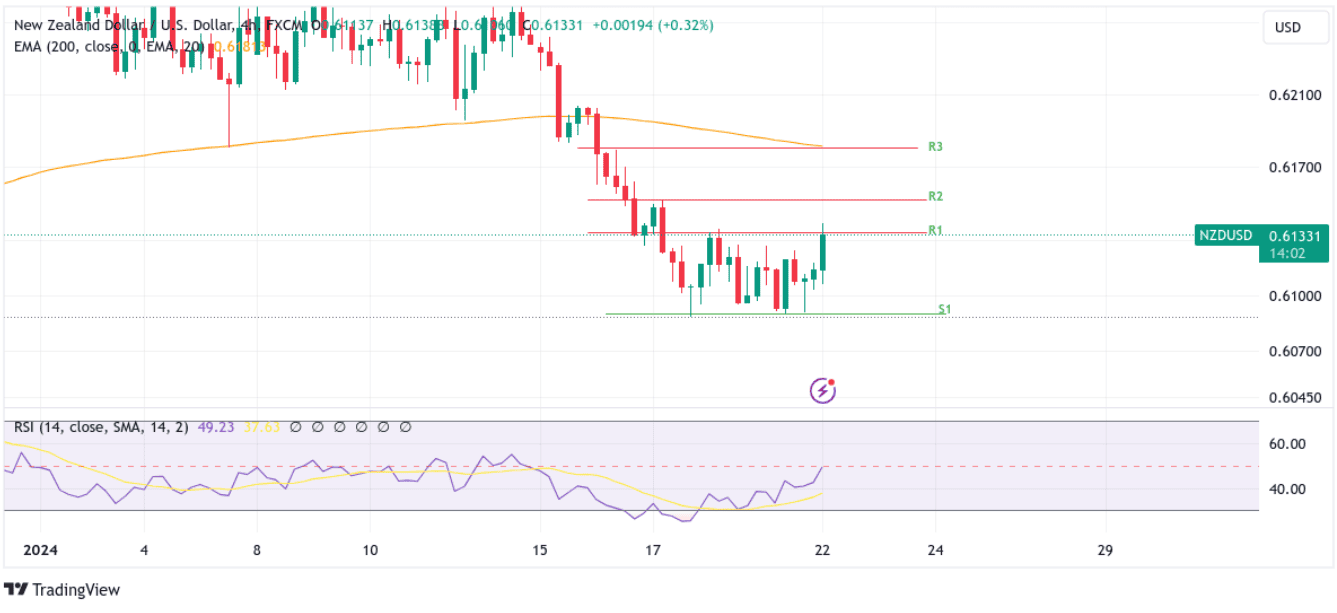NZD/USD Struggles To Capitalize On Break Above Upper Limit, Remains Capped Below 0.61400 Mark






Key Takeaways:
- The NZD/USD remains capped below the 0.61400 mark despite breaking above the upper range
- Retreating the U.S. Treasury bond yield weighs on the buck and helps cap the downside for the NZD/USD pair
- A combination of factors continues to lend support to the buck, which might help limit further gains around the NZD/USD pair
- The market's focus this week remains on the release of the U.S. quarter-four GDP and Core PCE data
The NZD/USD pair caught fresh bids during the early Asian session. They rose above the upper limit of the range they had been confided in since last week before paring gains and retracing below the aforementioned key resistance level as bulls failed to capitalize on the break. The shared currency remains capped below the 0.61400 mark.
The modest pullback in U.S. Treasury bond yields and a weaker risk tone undermine the greenback and are key factors that helped cap the downside for the NZD/USD cross.
This comes on the back of uncertainty over the Federal Reserve's (Fed) rate trajectory; however, markets seem convinced that the Fed will leave rates unchanged during the first two monetary policy meetings of the year (March and May) and start cutting rates during the third quarter of 2024.
This comes after markets saw influential FOMC members push back the idea of early rate cuts last week, warning that despite progress in tackling inflation, markets have gotten ahead of themselves regarding expectations for spring rate cuts.
Furthermore, a string of robust U.S. data released last week further helped push back the idea of early rate cuts. A U.S. Census Bureau report released on Thursday showed consumer spending at the retail level rose in December 2023 to 0.6%, following a 0.3% rise in November and beating forecasts of 0.4%. Moreover,
Moreover, the number of Americans filing for unemployment benefits fell by 16,000 to 187,000 in the week ending January 18th, the least since September 2022 and well below market expectations of 207,000. The data joins the NFP data released earlier this month in underscoring the historical tightness of the U.S. labor market, adding leeway for the Federal Reserve to prolong its hawkish stance into the second quarter, if necessary, to lower inflation.

Additionally, the University of Michigan's consumer sentiment for the U.S. soared to 78.8 in January 2024, the highest since July 2021, compared to 69.7 in December and forecasts of 70, preliminary estimates showed. Consumer views were supported by confidence that inflation had turned a corner and strengthened income expectations.
That said, the positive U.S. macro data combination remains supportive of the greenback. It might help limit further gains around the NZD/USD cross, warranting caution to traders against submitting aggressive bullish bets and waiting for strong through buying above the 0.61400 mark before confirming that the shared currency has broken free for the narrow range it has been confided in since late last week.
Moreover, the Kiwi continues to be undermined by the downbeat N.Z. macro data released on Friday, which showed the BusinessNZ Performance of Manufacturing Index in New Zealand declined to 43.1 in December 2023 from 46.7 in the prior month, contracting for the tenth straight month. It marked the lowest level since October 2023 and the second-lowest reading of the year.
Furthermore, the Kiwi continues to be undermined by a string of weak economic data from China, which has raised concerns about worsening economic conditions and mounting deflationary risks in the second-largest economy in the world.
As we advance, without any significant market-moving economic news data, the Treasury bond yields and the general market risk sentiment will continue to influence U.S. dollar dynamics and ultimately provide some trading opportunities around the NZD/USD cross. The main focus, however, remains on the release of the U.S. quarter-four GDP data report and the Fed's preferred inflation gauge, popularly known as the core PCE price index data report, on Thursday and Friday, respectively.
Technical Outlook: Four-Hour NZD/USD Price Chart

From a technical perspective, looking at the border picture, the NZD/USD pair has been oscillating in a familiar range over the last three trading days. The 0.61343 - 0.60897 region has supported spot prices and should now be a pivotal point. Price's inability to build on its earlier break today above the upper limit of the range and the subsequent retracement below the aforementioned level supports the case for further price reversal. The reason behind this could be attributed to the decision by traders to close down their winning positions amid sensing heavy overhead resistance lying above the pair, as shown by two key barriers (R2 and R3) and the technically strong 200-day (yellow) EMA level. Moreover, the RSI technical indicator on the four-hour chart is holding in negative territory, suggesting continuing the bearish price action for the rest of this week.
That said, if selling pressure increases beyond the current price level, the NZD/USD pair could drop toward the lower limit of the trading range. Sustained weakness below this level would reaffirm the bearish bias and pave the way for an accelerated decline toward the 0.60845 level route to the 0.60537 level. In extreme bearish cases, the NZD/USD pair could extend a leg down to the 0.60000 psychological mark.


